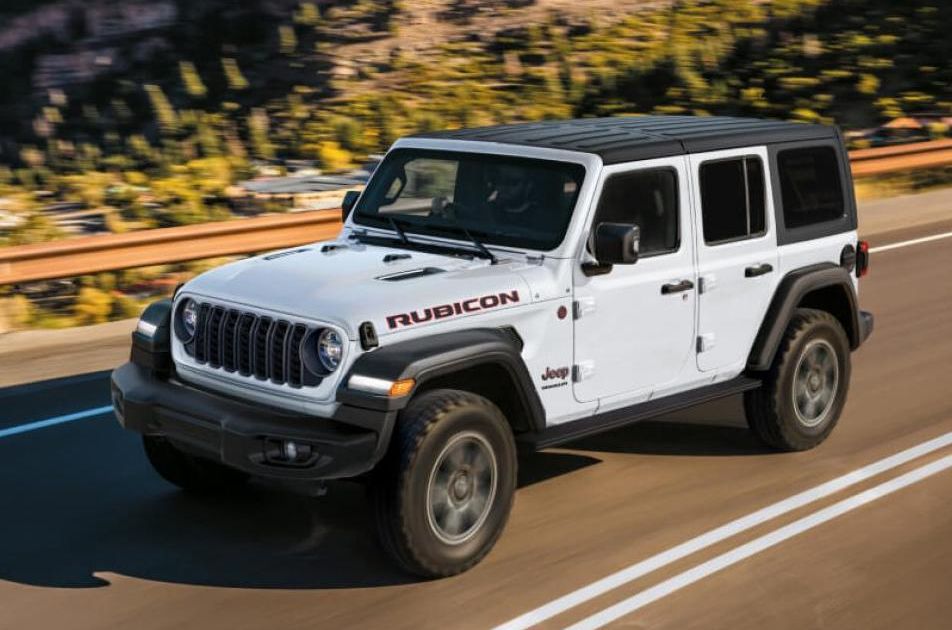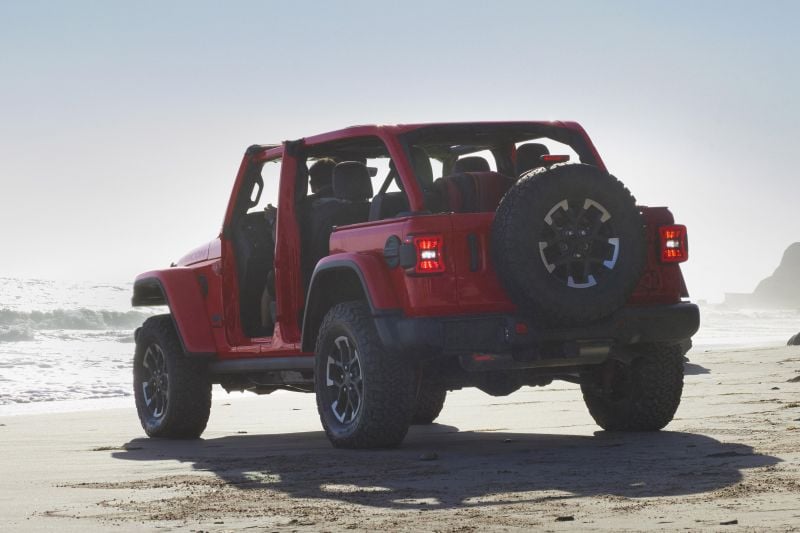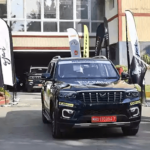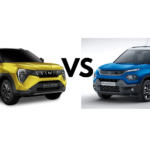

2024 Jeep Wrangler price and specs: Turbo-four engine brings price drop
[ad_1]
The price of entry to the Jeep Wrangler lineup has been reduced, coinciding with the arrival of a new turbocharged four-cylinder engine and tech upgrades for the off-roader.
For the first time in Australia, the Jeep Wrangler is now powered by a turbo-petrol engine, coming alongside significant updates to the fourth-generation model which launched in 2018.
Priced from $75,950 before on-road costs, the four-door Jeep Wrangler Sport S replaces the Night Eagle as the cheapest model in the range, undercutting its predecessor by $5500.
However, the Jeep Wrangler Sport S was first priced from $53,450 before on-road costs when it arrived in Australia in 2018, representing a $22,500 price increase across six years – though the level of standard equipment has also changed since then.
The Jeep Wrangler Overland continues as the mid-range variant, receiving a $2000 price cut by now starting from $84,950 plus on-road costs.
Jeep’s flagship Wrangler Rubicon off-road grades have avoided any price changes, remaining at $83,950 for the two-door and $90,450 as a four-door.
Outside of the new engine, there are comprehensive updates for the Wrangler, including a revised exterior look, a new interior with a 12.3-inch touchscreen, and more airbags for occupant safety.
The 2024 Jeep Wrangler is due in Australian showrooms from April 2024.
Pricing
- 2024 Jeep Wrangler Sport S four-door: $75,950 (-$5500 compared to previous entry-level Wrangler)
- 2024 Jeep Wrangler Overland four-door: $84,950 (-$2000)
- 2024 Jeep Wrangler Rubicon two-door: $83,950
- 2024 Jeep Wrangler Rubicon four-door: $90,450
All prices exclude on-road costs.
Drivetrains
The Jeep Wrangler is no longer exclusively powered by the ageing naturally aspirated Pentastar V6 petrol engine, instead adopting a turbocharged 2.0-litre four-cylinder petrol engine.
Jeep’s new engine produces 200kW of power and 400Nm of torque – a 9kW drop compared to the Pentastar but 53Nm more than its V6 predecessor – which is mated to an eight-speed automatic transmission.
The Jeep Wrangler S and Overland are equipped with a Selec-Trac 4×4 System that can automatically transition between two- and four-wheel drive.
Rubicon grades gain a Rock-Trac 4×4 system, adding a 4:1 low-gear ratio, a 77.2:1 crawl ratio, Tru-Lok electronic locking front and rear differentials, plus an electronic front sway bar disconnect.
Efficiency
The 2024 Jeep Wrangler is more fuel efficient than its predecessor, with the non-Rubicon four-doors consuming a claimed 9.2L/100km on the combined cycle – down from 9.7L/100km.
Rubicon examples consume 9.9L/100km on the same test cycle, representing a saving of 0.2L/100km for the two-door and 0.4L/100km for the four-door.
While the two-door Rubicon has a 66L fuel tank, the four-door Wrangler grows to 81L. Premium unleaded petrol with a minimum 95 octane rating is now required, rather than the 91 octane which could power the V6.
Dimensions
The 2024 Jeep Wrangler two-door measures 4334mm long, 1894mm wide, and 1894mm tall with a 2459mm wheelbase – growing 33mm in height.
The four-door Wrangler is understandably larger, stacking up as 4882mm long, 1894mm wide, and 1901mm tall, riding on a 3008mm wheelbase.
Front and rear track measurements are unchanged at 1598mm.
Jeep says the Wrangler’s 750kg unbraked and 2495kg braked towing capacity figures for the four-door are unchanged – though the two-door retains its 1497kg braked towing capacity.
Servicing and Warranty
Jeep has set service intervals of 12,000km and 12 months (whichever comes first) for the new Wrangler, with capped prices of $399 for the first five services – covering 60,000km.
The Wrangler is also covered by a five-year, 100,000km warranty, with lifetime roadside assistance offered provided the vehicle is serviced through an official Jeep dealer.
Safety
The 2024 Jeep Wrangler is as yet untested by ANCAP, though the current generation was awarded a three-star safety rating in 2019.
All Wranglers come with the following safety equipment as standard:
- Autonomous emergency braking
- Blind-spot monitoring
- Rear cross-traffic alert
- Adaptive cruise control
- Reversing camera
- Front and rear parking sensors
- Front and front-side airbags
- First- and second-row side curtain airbags (NEW)
Standard Equipment
There are three Wrangler trim levels available.
The 2024 Jeep Wrangler Sport S comes with the following features:
- 17-inch alloy wheels
- Nexen Roadian A/T tyres
- Regular-duty suspension
- Automatic LED headlights
- Automatic high-beam
- Front Gorilla Glass windshield
- Windshield-mounted antenna
- 12.3-inch touchscreen infotainment system
- Wireless CarPlay and Android Auto
- Satellite navigation
- DAB digital radio
- Nine-speaker Alpine sound system
- Climate control
- Ambient LED interior lighting
- Fabric dash panel
- 240A alternator
- Heated steering wheel
- Black cloth upholstery
- Heated front seats
- Side curtain airbags
- Rear seat reminder
- Proximity entry with push-button start
The Wrangler Overland adds:
- 18-inch alloy wheels
- Anti-spin Dana M220 rear axle
- Black side mirrors
- Soft spare tyre cover
- Premium ‘McKinley’ seats
- Front 12-way power seats with four-way lumbar adjustment
- Hard seatback panel
The flagship Wrangler Rubicon loses its 12-way power passenger seat, but adds:
- 17-inch alloy wheels with 32-inch off-road tyres
- Performance suspension
- Electronic front sway bar disconnect
- Heavy-duty Dana full-float rear axle
- Acoustic laminated front door glass
- Forward-facing TrailCam
- Premium wrapped dash panel
- Black Nappa leather-trimmed upholstery
- Rear seat reminder
Options
- Sky-one-touch power top (Overland and Rubicon four-door only): $6450
- 18-inch seven-spoke wheels (Overland four-door only): $950
Colours
The 2024 Jeep Wrangler is available in a choice of 11 exterior paint finishes, with all but the base Bright White costing $1490:
- Bright White
- Black
- Firecracker Red
- Sarge
- Hydro Blue
- High Velocity
- Silver Zynith
- Earl
- Granite Crystal
- Anvil
- Tuscadero (from March 2024 production onwards)
MORE: Everything Jeep Wrangler
[ad_2]
Source link
Add a comment Cancel reply
Categories
- Car News (2)
- Cars News (91)
- Electric Cars (76)
- Electric Two-wheeler (76)
- Electric Vehicle (76)
- Experts Reviews (2)
- Gallery (11)
- New Arrivals (378)
- Uncategorized (1)
- Used Cars (54)
- XUV Cars (2)














